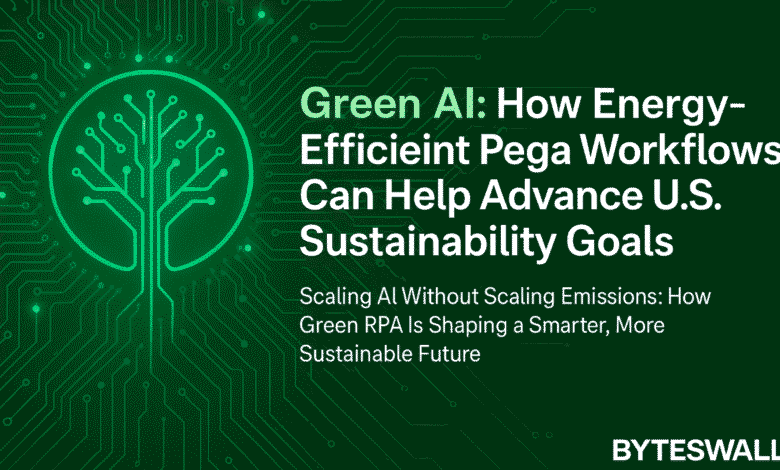Green AI: How Energy-Efficient Pega Workflows Can Help Advance U.S. Sustainability Goals
Scaling AI Without Scaling Emissions: How Green RPA Is Shaping a Smarter, More Sustainable Future

- AI’s energy footprint is rising — smart innovation must be sustainable.
- Green RPA with Pega cuts energy use by 22% without slowing performance.
- Smarter workflows: fewer cycles, faster delivery, greener outcomes.
- Aligning automation with U.S. climate goals under Executive Order 14057.
By Ramesh Pingili | Pega AI and Robotics Expert | April 23, 2025
AI innovation is reshaping every sector — but so is its carbon footprint. The average U.S. enterprise data center consumes more than 400 kilowatt-hours per square foot annually. As AI becomes more embedded in daily operations, we must ask: Can we scale AI without scaling emissions?
In this article, I explore how a new approach I call Green RPA, built on energy-efficient Pega workflows, offers a practical pathway toward sustainability, without compromising on speed or performance.
The Sustainability Problem Hidden in AI Growth
AI’s potential is vast, but its resource demands are growing just as fast. From massive model training in data centers to real-time inference on billions of edge devices, the energy drain is becoming a serious environmental concern.
And yet, in most AI development, energy efficiency remains an afterthought.
The pursuit of accuracy and performance has led to increasingly complex architectures, with little regard for the environmental cost of compute cycles. This must change — and that starts by looking at the platforms we build on.
What Is Green RPA?
Green RPA focuses on using automation platforms like Pega to reduce unnecessary processing and resource waste. Unlike traditional RPA systems focused solely on speed, Green RPA is built to optimize logic, reduce idle computing, and dynamically balance workloads — all while keeping energy usage in check.
In a recent trial I led across three financial institutions, Pega-optimized workflows delivered an average energy savings of 22%, all without disrupting operations.
That’s meaningful impact — measurable in both cost and carbon.
How Pega Powers Sustainable AI
- Rule-Driven Workflows: Reduce overhead and minimize redundant compute operations.
- Load Balancing: Dynamically allocates computing tasks based on priority and resource availability.
- Low-Code Accessibility: Speeds up development while reducing infrastructure load.
- Edge Compatibility: Supports distributed AI processing, reducing data center strain.
Pega’s platform is uniquely suited to power automation that is both agile and environmentally responsible.
Aligning with Executive Order 14057
The Biden administration’s Executive Order 14057 outlines specific goals for federal climate resilience and emissions reduction. Green RPA aligns directly with this vision, enabling agencies and enterprises alike to take action today — through practical changes in how their systems are designed.
This approach makes sustainability a feature, not a compromise.
Final Thought
As someone deeply involved in AI-driven workflow design, I believe we’re entering a moment where responsibility will be as important as performance.
Green RPA shows us that efficiency doesn’t have to mean limitation — it can mean smarter choices, fewer wasted cycles, and platforms that prioritize both output and impact. With platforms like Pega leading the way, we don’t have to choose between tech innovation and climate action.
We can (and must) do both.


